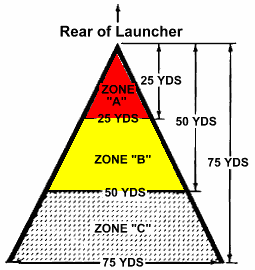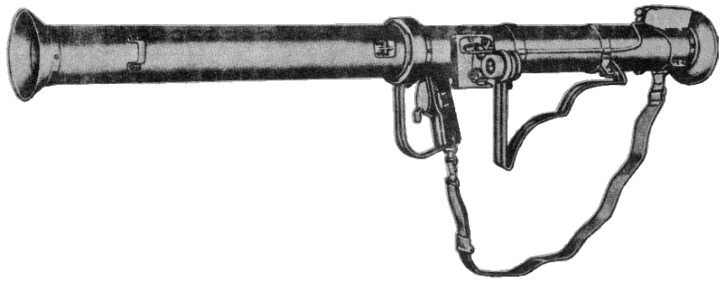The M20A1 and M20A1B1 rocket launchers are two-piece smooth-bore weapons of the open tube type and are fired by
an electrical firing mechanism, which contains a magneto that provides the current and is located in the trigger grip.
These launchers are designed to be fired from the shoulder in standing, kneeling, sitting, or prone position.
To reduce weight, the barrels and many of the components are made of aluminum.
These launchers are designed to launch high explosive rockets and smoke rockets against ground targets. These
high-explosive antitank rockets are capable of penetrating heavy armor at angles of impact greater than 30°.
Replaced the M9A1 2.36 inch (60 mm) rocket launcher. The M20 rocket launcher was used extensively during the
Korean War, where its HEAT rocket proved effective against T34 tanks. No longer in U.S. service.
Replaced by the M72 LAW.

Ammunition is issued in the form of complete rounds of fixed ammunition. The term "fixed", signifies that the
propelling charge is fixed (not adjustable) and that the round is loaded into the launcher as a unit.
The complete round consists of a rocket head, a fuse, and a rocket motor which contains the propellant and
igniter. A tail assembly is rigidly attached to the rear of the motor. The fuse body, threaded at both ends,
serves also as a coupling for the rocket head and motor.
The same model rocket motor is common to all complete rounds. The motor assembly is threaded externally at the
forward end to engage the fuze. The rocket motor propelling charge consists of 12 nonperforated cylindrical extruded
grains of M7 solvent propellent. Each grain is 5 inches long, approximately 3/8 inch in diameter and weighs 0.03 pound.
The propellent grains are positioned lengthwise, three in each of four compartments.
The PI-BD (point initiating base detonating) M404 series rocket fuze is of the simple inertia (setback arming) type
which functions with non-delay action upon impact or graze. Upon impact, the activating plunger moves forward
activating the lever action of the firing pin. This drives the firing pin into the detonator and explodes the rocket.
The M405 dummy fuze is an inert fuze similar in appearance to the M404 series.
Temperature Limits: -20°F to +120°F

3.5 inch rockets.
| Model |
Type |
Unit Weight |
Unit Length |
Rocket Head Weight |
Rocket Head Length |
Filler |
Fuze |
| M28A2 |
HEAT |
9.00 lb (4.08 kg) |
23.55 in (598.2 mm) |
4.54 lb (2.06 kg) |
10.58 in (268.7 mm) |
1.88 lb (0.85 kg) Composition B |
PI-BD M404A1 or M404A2 |
| M29A2 |
Practice |
8.96 lb (4.06 kg) |
23.55 in (598.2 mm) |
4.65 lb (2.11 kg) |
10.58 in (268.7 mm) |
Inert |
Dummy M405 |
| M30 |
WP |
8.96 lb (4.06 kg) |
23.55 in (598.2 mm) |
4.47 lb (2.03 kg) |
10.58 in (268.7 mm) |
2.33 lb (1.06 kg) white phosphorus |
PI-BD M404A1 or M404A2 |
Rocket, HEAT, 3.5-Inch, M28A2

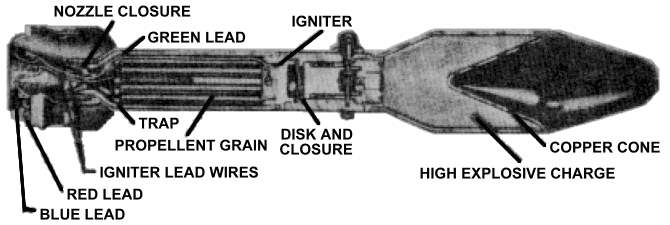
Intended for penetration of armored targets.
The head of this rocket consists of a thin gage steel body, cylindrical in shape and tapered at the rear. The
cylindrical portion is 3.5 inches in diameter: the rear of the tapered portion, approximately 2 inches. The body
contains a copper cone, whose apex is to the rear, which acts to shape the high explosive charge of approximately,
1.88 pounds of Composition B. The penetration effect is derived from the shaped charge. The forward end of the body
is closed by a tapered thin gage metal ogive. The head is threaded internally at the rear to receive the fuze.
Olive drab body with yellow markings.
Rocket, Practice, 3.5-Inch, M29A2
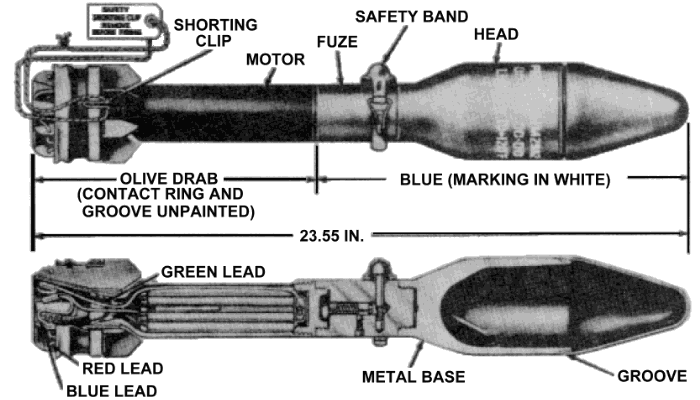
Simulates the service rockets, has an inert head, and is intended for target practice purposes.
The head of this practice rocket is similar in external contour to the lead of the M28A2 HEAT Rocket, except for
a circumferential groove in the head at tile juncture of the lead body and ogive due to the crimp by which the ogive
and body are secured. The head, which is hollow, is threaded internally at the rear to receive a dummy fuze. An
earlier manufacturing alternative is identical in contour with the head of the M28A2 HEAT Rocket, except for the
lack of the crimping groove, consisting of the metal parts of the service head inert loaded with plaster of paris.
Blue body with white markings.
Rocket, Smoke, 3.5-Inch, WP, M30 (T127E3)
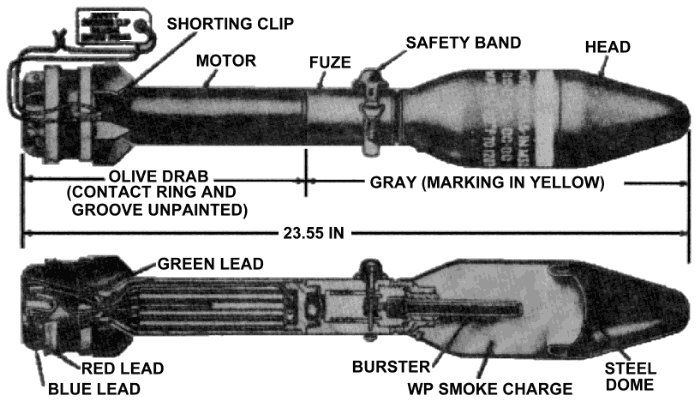
Intended to produce screening or signaling smoke.
The head of these rockets is similar in external contour to the head of the M28A2 HEAT rocket. The head is
internally threaded at the rear end and contains a 2.33 pound charge of white phosphorus. At the rear it has
a union internally threaded to receive the fuze, the M8 burster casing is press fitted into the union, and the
steel body fitted over it. The steel ogive and the internal steel dome, which close the forward end of the filler
cavity, are attached to the body.
Gray body with yellow markings and 1/2 inch wide band, approximately 5 inches from nose end.
- Zone A: The blast area, should be clear of all personnel, ammunition, materiel, and flammables,
such as dry vegetation. The danger in this area is from the blast of flame to the rear of the launcher and
the rearward flight of nozzle closures and/or igniter wires.
- Zone B: Should be clear of all personnel, ammunition, and materiel unless protected by adequate shelter.
The principal danger in this zone is from the rearward flight of nozzle closures and/or igniter wires.
- Zone C: Additional safety factor for training only.
Since the rocket may burn for a time after projection from the launcher thereby placing the operating personnel
in the back blast areas, eye protection in the form of goggles or similar equipment with safety glass lenses is
mandatory at temperatures of 70°F, and above.
At temperatures below 70°F, rockets may be expected to produce blowback of propellant particles after projection
from the launcher. Therefore, at temperatures below 70°F, the use of field protective mask or goggles and hand
protection is mandatory for all operating personnel.





 Intended for penetration of armored targets.
Intended for penetration of armored targets.
 Simulates the service rockets, has an inert head, and is intended for target practice purposes.
Simulates the service rockets, has an inert head, and is intended for target practice purposes.
 Intended to produce screening or signaling smoke.
Intended to produce screening or signaling smoke.
